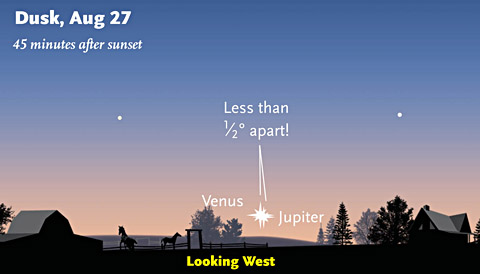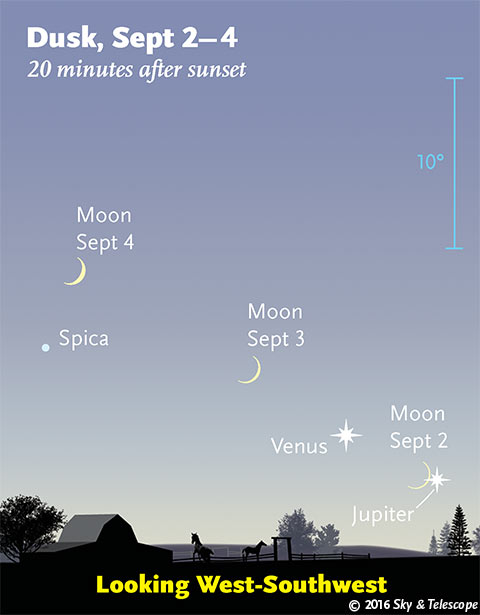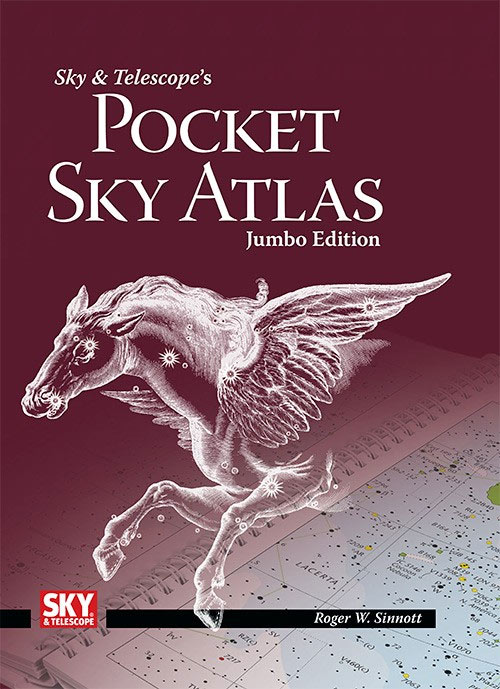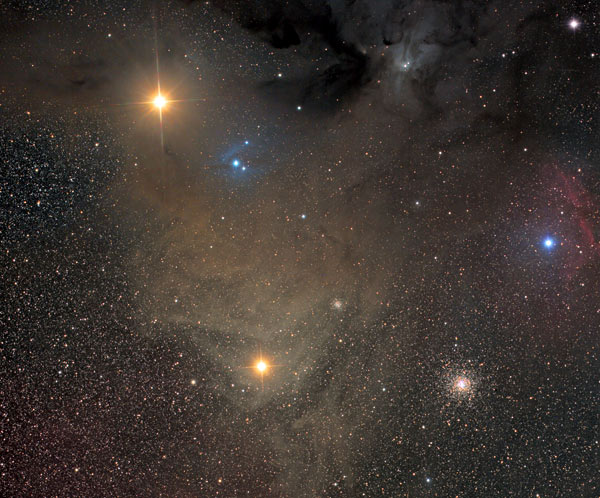Friday, August 26
• Venus and Jupiter have closed to only 1° apart, very low in the west after sunset. That's less than a finger-width at arm's length. See tomorrow's entry.

Saturday, August 27
• Venus-Jupiter conjunction. Starting about 20 minutes after sunset, look low above the horizon due west, left of where the Sun went down. Bring binoculars. The two planets will be less than ½° apart at the time of twilight for most of the world, and only about 0.1° apart for the longitudes of the Americas. That's so close that you may need the binoculars to see that they are two objects, not one!
And you might try for much fainter Mercury, 5° to their lower left in bright twilight (for North America). Good luck; Mercury has faded down to magnitude +0.8.
Sunday, August 28
• You can tell that summer's days are numbered: when darkness falls, Cassiopeia has risen about as high in the northeast as the Big Dipper has declined in the northwest.
• Also, with August nearing its end, you can say hello to the Double Cluster in Perseus without having to stay up late. After dark, find the tilted W of Cassiopeia partway up the northeastern sky. Note the two stars of its lower-left segment (the faint end of the W). Using binoculars, aim at the midpoint between them and then drop down by a little more than the full width of the binocular's view (for typical binoculars). Look for two little irregular cotton puffs, touching each other and tilted diagonally.
With a dark enough sky you can even make them out with the unaided eye, as a distinct enhancement of the background Milky Way.
Monday, August 29
• Crisp nights of late summer are prime Milky Way time, as hot-weather humid hazes give way to dryer, clearer air (at least where a lot of us live). After dark, the Milky Way runs from Sagittarius in the south, up and left across Aquila, through the big Summer Triangle very high in the east, and on down through Cassiopeia to Perseus rising low in the north-northeast.
Tuesday, August 30
• If you live in the world's mid-northern latitudes, look for bright Vega passing your zenith around nightfall. Vega goes right through the zenith if you're at latitude 39° north: for instance, near Baltimore, Kansas City, Lake Tahoe, Sendai, Beijing, Athens, Lisbon.
Wednesday, August 31
• Before the Moon returns to light the evening next week, explore some lesser-known deep-sky sights in and around Cygnus overhead with Sue French's Deep-Sky Wonders column and charts in the September Sky & Telescope, page 54. And in the Swan's northwest wing, learn the binocular asterism Vultus Irrisorie, the Smiley Face. You'll never forget it.
Thursday, September 1
• This evening the Saturn-Mars-Antares triangle is perfectly isosceles: 6.1, 6.1, and 4.9 degrees on a side (at nightfall in the Americas). Think photo opportunity.
• An annular eclipse of the Sun crosses central Africa from Gabon to Madagascar today. The eclipse is partial for most of Africa and the Indian Ocean. Maps and details.
• Accordingly, it's new Moon (exact at 5:03 a.m. Eastern Daylight Time).

Friday, September 2
• A twilight challenge: Shortly after sunset, use binoculars or a wide-field scope to start looking for the super-thin crescent Moon near Jupiter and Venus in the bright sky just above the west-southwest horizon, as shown at right. The Moon will be much easier tomorrow.
Saturday, September 3
• Shortly after sunset, the crescent Moon low in the west-southwest points the way lower right to Venus and lesser Jupiter, as shown at right.
_________________________
Want to become a better astronomer? Learn your way around the constellations! They're the key to locating everything fainter and deeper to hunt with binoculars or a telescope.
This is an outdoor nature hobby. For an easy-to-use constellation guide covering the whole evening sky, use the big monthly map in the center of each issue of Sky & Telescope, the essential guide to astronomy.

Once you get a telescope, to put it to good use you'll need a detailed, large-scale sky atlas (set of charts). The basic standard is the Pocket Sky Atlas (in either the original or new Jumbo Edition), which shows stars to magnitude 7.6.
Next up is the larger and deeper Sky Atlas 2000.0, plotting stars to magnitude 8.5, nearly three times as many. The next up, once you know your way around, is the even larger Uranometria 2000.0 (stars to magnitude 9.75). And read how to use sky charts with a telescope.
You'll also want a good deep-sky guidebook, such as Sue French's Deep-Sky Wonders collection (which includes its own charts), Sky Atlas 2000.0 Companion by Strong and Sinnott, or the bigger Night Sky Observer's Guide by Kepple and Sanner.
Can a computerized telescope replace charts? Not for beginners, I don't think, and not on mounts and tripods that are less than top-quality mechanically (meaning heavy and expensive). And as Terence Dickinson and Alan Dyer say in their Backyard Astronomer's Guide, "A full appreciation of the universe cannot come without developing the skills to find things in the sky and understanding how the sky works. This knowledge comes only by spending time under the stars with star maps in hand."
This Week's Planet Roundup

Mercury is fading and disappearing into the sunset, ever farther below Venus and Jupiter.
Venus and Jupiter are very low in bright twilight, shining at magnitudes –3.8 and –1.7 respectively. After their close conjunction on August 27th (see the top of this page), Venus creeps a little higher each night and Jupiter sinks farther to Venus's lower right. Their separation grows by 1° per day. Bring binoculars.
Mars (magnitude –0.3, in upper Scorpius) moves rapidly eastward away from Saturn (magnitude +0.4) and Antares (+1.0, below Saturn). Look for them in the southwest after dusk. The triangle they make is again widening.
Uranus (magnitude 5.8, in Pisces) and Neptune (magnitude 7.8, in Aquarius) are well up by midnight in the southeast and south, respectively. Info and finder charts.
__________________________
All descriptions that relate to your horizon — including the words up, down, right, and left — are written for the world's mid-northern latitudes. Descriptions that also depend on longitude (mainly Moon positions) are for North America.
Eastern Daylight Time (EDT) is Universal Time (UT, UTC, or GMT) minus 4 hours.
__________________________
"This adventure is made possible by generations of searchers strictly adhering to a simple set of rules. Test ideas by experiments and observations. Build on those ideas that pass the test. Reject the ones that fail. Follow the evidence wherever it leads, and question everything. Accept these terms, and the cosmos is yours."
— Neil deGrasse Tyson
 2
2








Comments
August 27, 2016 at 5:41 pm
Observed the conjunction today at sunset (18.16UT) with my 8x40 binoculars. The planets were 0.2 dgr apart, 15 min later clouds ended the show! J
You must be logged in to post a comment.
Joe Stieber
August 28, 2016 at 6:16 pm
From New Jersey, USA, I watched the pair for half an hour starting at 7:50 pm EDT (23:50 UT) on August 27 when they descended out of a cloud bank into relatively clear sky. Brilliant Venus was initially spotted with 16x70 binoculars and nearby ghostly Jupiter was seen a moment later. I was distracted, so I didn't notice Venus with unaided eyes until about 8 pm (00:00 UT on 8/28). I thought I glimpsed Jupiter too, but dismissed it because I didn't think it was possible to see it so close to brilliant Venus. However, by 8:08 pm, I was quite certain that I was seeing Jupiter with my unaided eyes. In any case, they looked splendid with and without the binoculars. The pair was about 5 arc minutes apart when I first spotted them and 6 arc minutes apart when they disappeared behind distant trees around 8:20 pm. Sunset was at 7:38 pm EDT.
You must be logged in to post a comment.
You must be logged in to post a comment.